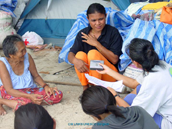Disaster Risk Reduction

- UNESCO/CSI/LINKS, Bangkok
- Tsunami of 26 December 2004 - UNESCO CSI-LINKS project leader Narumon Arunotai interviewing elderly Moken woman on indigenous knowledge of the tsunami ('La Boon' in Moken)
Natural hazards are naturally-occurring physical phenomena caused by either the rapid or slow onset of events having atmospheric, geologic and hydrologic origins on solar, global, regional, national and local scales. They include earthquakes, volcanic eruptions, landslides, tsunamis, floods, tropical cyclones, and drought and desertification.
Natural disasters are the combination of hazards, conditions of vulnerability and insufficient capacity or measures to reduce the potentially negative consequences of risk.
But natural disasters are not entirely "natural", for people are agents of disasters. For instance severe flooding may be exacerbated by deforestation. An increasing burden of risk is largely due to inappropriate development decisions. For example, populations are often concentrated on natural flood plains or along known earthquake fault lines, or in cities and settlements where houses and infrastructures are not safely built and where land use is poorly planned, leading to disastrous effects in the event of an earthquake, even a slight one. With greater urbanization and the infrastructure that this entails, losses have soared dramatically.
What is not generally realized is that many disasters could have been greatly mitigated with adequate forethought and preparation, and that the cost of this mitigation would have been small compared to the cost of relief and recovery efforts.
The main fields of action, as defined by the International Strategy for Disaster Reduction (ISDR), include risk awareness and assessment; knowledge development; public commitment and institutional frameworks; and early warning systems including forecasting, dissemination of warnings, preparedness measures and reaction capacities.
There is a basic relationship between development and disaster-proneness. Consequently, poor and developing countries suffer the greatest damage in life losses, in social and economic terms because of their lack of resources, infrastructures and protective systems for disaster preparedness and prevention. UNESCO is closely involved in raising public awareness and improving education about natural disasters, two certain ways of helping vulnerable populations to cope with risk.
- Risk Assessment and Monitoring
- Building Understanding and Awareness
- Preparedness and Mitigation

Tsunami Teacher
More

UNESCO's role : Disaster Preparedness and Mitigation
More

- 06-04-2009



